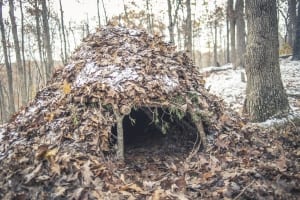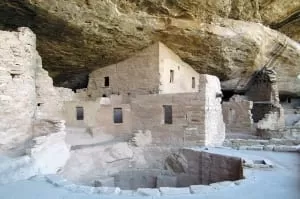The three shelter categories are: hasty, semi-permanent, and permanent. Shelter is one of the core essentials of survival. Thus, it makes sense to have a working knowledge of the categories of shelter. A person can die from environmental exposure in as little as three hours without shelter. Of course, this rule is dependent on environmental and health factors. Furthermore, it is helpful to remember that there are many types of shelters within each category. Therefore, it is beyond the scope of this article to discuss all of the styles of shelter construction.
Shelter Category # 1: Hasty or Temporary Shelters
The most common type of wilderness or emergency shelter is known as the hasty shelter or temporary shelter. This shelter category has a quick construction. They also give temporary relief from environmental conditions. Debris shelters, wickiups, lean-tos, or one-person tents are examples of this shelter category. The best hasty shelters make good use of available natural resources. Sometimes, they combine both natural and manufactured materials such as leaves, branches, trash bags, and trekking poles. In the military, hasty shelters are nick-named, hootches, and feature the use of the military-issue rain poncho.
Advantages
The main advantage of this shelter category is the relative ease of construction. They can be constructed within a few minutes to a couple of hours depending on what you are trying to build. Hasty shelters that are made well are effective in keeping precipitation off of you and your gear. They also deflect wind from off of your body.
Another advantage of hasty shelters is they are efficient in helping maintain the core temperature of your body. Great shelters, regardless of natural or man-made, will help you stay warm or cool as well as keep you dry. However, the critical point here is knowing how to build a hasty shelter correctly out of natural materials.
Disadvantages
There are some disadvantages with this shelter category. One problem with hasty shelters is that they have limitations in their ability to protect you from exposure to environmental factors. Wind, rain, heat, and cold can still get to you through a hasty shelter, although not as much as if you were exposed. Moreover, hasty shelters require some skill and experience in building them correctly in various environments. For example, one famous survival television personality failed miserably to make an igloo shelter in the artic with limited knowledge and no experience in building them. Building shelters from natural materials can be problematic for those with little experience. In a survival situation, the inability to put up an adequate shelter with natural resources under adverse conditions could be disastrous.
Factors Influencing Use
There are some underlying factors to consider when deciding upon the kind of hasty shelter to construct. These factors are time, terrain, and available natural resources. For example, military personnel trained in sophisticated survival, escape, and evasion techniques, are moving most of the time. Therefore, they will not construct very elaborate shelters in the field. They will build a shelter to get them through the night and move on the next day. By contrast, someone on a multiday hike may decide to put up a Snugpak® Ionosphere™ tent in which to spend the night, rather than build a debris hut.
Furthermore, it is important to remember that some terrain does not provide enough natural resources to build an adequate shelter for this shelter category. Therefore, it is good to carry a reliable manufactured single-person tent into the field as a backup if possible. Marmot, Kelty, MSR, and Nemo are companies that offer pack-friendly tents.
Shelter Category # 2: Semi-Permanent Shelters
The next shelter category is semi-permanent. As the name implies, these shelters are more permanent than hasty shelters. The classic example of semi-permanent shelters would be the native-American Tee-pee. Other examples in this shelter category are the Bedouin family tent, or a large military tent, like the U.S. Army DRASH tents. The Tentipi Safir 5 Light Tent is another example of a semi-permanent shelter. However, bamboo, sod homes, or grass hut dwellings could be included in the semi-permanent shelter category. Additionally, log cabins can be semi-permanent or permanent depending on their construction. Therefore, a semi-permanent shelter is one that has no permanent anchor to the ground by attachment to a foundation.
Advantages
One Advantage of semi-permanent shelters is they offer better protection from the elements of the weather. They also give better protection against the large predatory animals, such as bears, wolves, or cougars. Another advantage of semi-permanent shelters is that they are transportable if necessary. The mobility of semi-permanent shelters is not as easy as a single-person tent. Nevertheless, they are mobile. The sustainment of the Native-American tribes came by following the vast buffalo herds. Consequently, their family shelters had to move with them.
Disadvantages
A significant disadvantage of this shelter category is that they are susceptible to destruction by high winds. High winds can topple these kinds of shelter because of not having a permanent anchor to the ground. Another disadvantage is that they require more effort to move than a hasty shelter. In the middle east, the Bedouin tribes have to move large carpets and blankets that are their tent covers. Breaking down an enclave of semi-permanent shelters and moving them takes much energy to accomplish.
Factors Influencing Use
A few factors to consider about building a semi-permanent shelter. First, what is the purpose of the shelter? If you are continually trekking over terrain, constructing a semi-permanent shelter is not the best use of time or resources. However, if you are looking to stake a claim and set up a homestead, then a semi-permanent shelter is wise. Another factor to consider is location. Is there enough area and natural resources to build a semi-permanent shelter? If the place cannot sustain you with adequate food, water, and arable soil, then your semi-permanent shelter may have to be moved.
Shelter Category # 3: Permanent Shelters
Permanent shelters are the final category of consideration. A person building a permanent shelter signals an intent to stay in one place for a long time. Permanent shelters can sit on a foundation of rock, brick, or concrete. The dwelling is anchored to the foundation in such a manner that the building does not move, even in high winds. Permanent shelters take a considerable amount of time to construct, especially with the use of masonry.
Furthermore, it takes a higher level of skill and knowledge to build a permanent shelter. An example of a permanent shelter would be a suburban family residential home. However, caves could be a kind of permanent housing, even though a person does not build a cave, he only occupies it.
Advantages
A significant advantage of a permanent shelter is that it is considerably more resistant to environmental factors, such as wind, rain, or cold. Permanent shelters also give better protection against predators. Another advantage of permanent shelters is that they offer a one-building solution to shelter a family. Additionally, they provide some social, emotional, and psychological stability to people due to the permanence that they bring.
Disadvantages
One disadvantage of a permanent shelter is that it is in immobile in all practicality. Permanent shelters require a tremendous amount of time and resources to construct. Typically, survival reasons cause people to abandon their permanent shelters. The Anasazi peoples of the southwest United States abandoned their permanent shelters (see pic). Moreover, the recent flooding from hurricanes and the wildfires in California give a stark reality to leaving permanent shelters for the sake of safety or survival.
Factors Influencing Use
A consideration of some important factors should influence decisions about building a permanent shelter. The first factor is deciding if living in a particular location is going to be permanent. Arable land, water, game, and other natural resources will dictate if an area is going to sustain a long-term settlement. Another factor is your personal experience and knowledge in building a permanent shelter. You may need to solicit help with making such a shelter. Is there assistance available?
Final Thoughts
Shelter is one of the core essentials of survival. Every human being needs shelter to enable long-term survival. Our human experience integrates the three categories of shelters to survive in this world. Thus, it is essential to know these categories to help make decisions about what kind of shelter to construct. An outdoor emergency in the wilderness will not facilitate a semi-permanent or permanent shelter. A person’s main task under those circumstances is to make it out alive. Thus, becoming adept at constructing hasty shelters from natural resources is one of those crucial tasks to master before going for a long trek outdoors.
This post may contain affiliate links which means I may receive a commission from purchases made through the links. I only recommend products I personally use and love, so if you support what we are doing, thanks for clicking.













